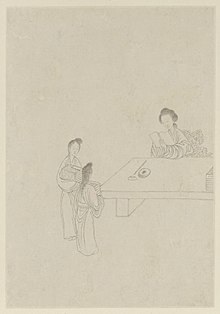
Back بان تجاو Arabic بان تجاو ARZ Ban Zhao Catalan بان ژاوۆ CKB Pan Čao Czech Ban Zhao German Ban Zhao Spanish Ban Zhao Basque بان ژاو Persian Ban Zhao Finnish
Ban Zhao | |
|---|---|
 Ban Zhao, as painted by Gai Qi, 1799 | |
| Born | AD 45 or 49 |
| Died | 120 (aged 70–71) China |
| Spouse | Cao Shishu |
| Parent | Ban Biao |
| Relatives | Ban Chao (brother) Ban Gu (brother) |
| Ban Zhao | |||||||||||||||||||||
|---|---|---|---|---|---|---|---|---|---|---|---|---|---|---|---|---|---|---|---|---|---|
| Chinese | 班昭 | ||||||||||||||||||||
| |||||||||||||||||||||
| Alternative Chinese name | |||||||||||||||||||||
| Chinese | 惠班 | ||||||||||||||||||||
| Literal meaning | Ban the Kind | ||||||||||||||||||||
| |||||||||||||||||||||
| Second alternative Chinese name | |||||||||||||||||||||
| Chinese | 曹大家 | ||||||||||||||||||||
| Literal meaning | Venerable Madame Cao | ||||||||||||||||||||
| |||||||||||||||||||||
Ban Zhao (Chinese: 班昭; 45 or 49 – c. 117/120 CE), courtesy name Huiban (Chinese: 惠班), was a Chinese historian, philosopher, and politician. She was the first known female Chinese historian and, along with Pamphile of Epidaurus, one of the first known female historians. She completed her brother Ban Gu's work on the history of the Western Han, the Book of Han. She also wrote Lessons for Women, an influential work on women's conduct. She also had great interest in astronomy and mathematics and wrote poems, commemorative writings, argumentations, commentaries, essays and several longer works,[1] not all of which survive. She became China's most famous female scholar[2] and an instructor of Taoist sexual practices for the imperial family.[3] Ban Zhao is depicted in the Wu Shuang Pu (無雙譜, Table of Peerless Heroes) by Jin Guliang.
- ^ Wang 2003, p. 177
- ^ Perkins 2000, p. 25
- ^ Gender and Sexuality in Modern Chinese History By Susan L. Mann page 88